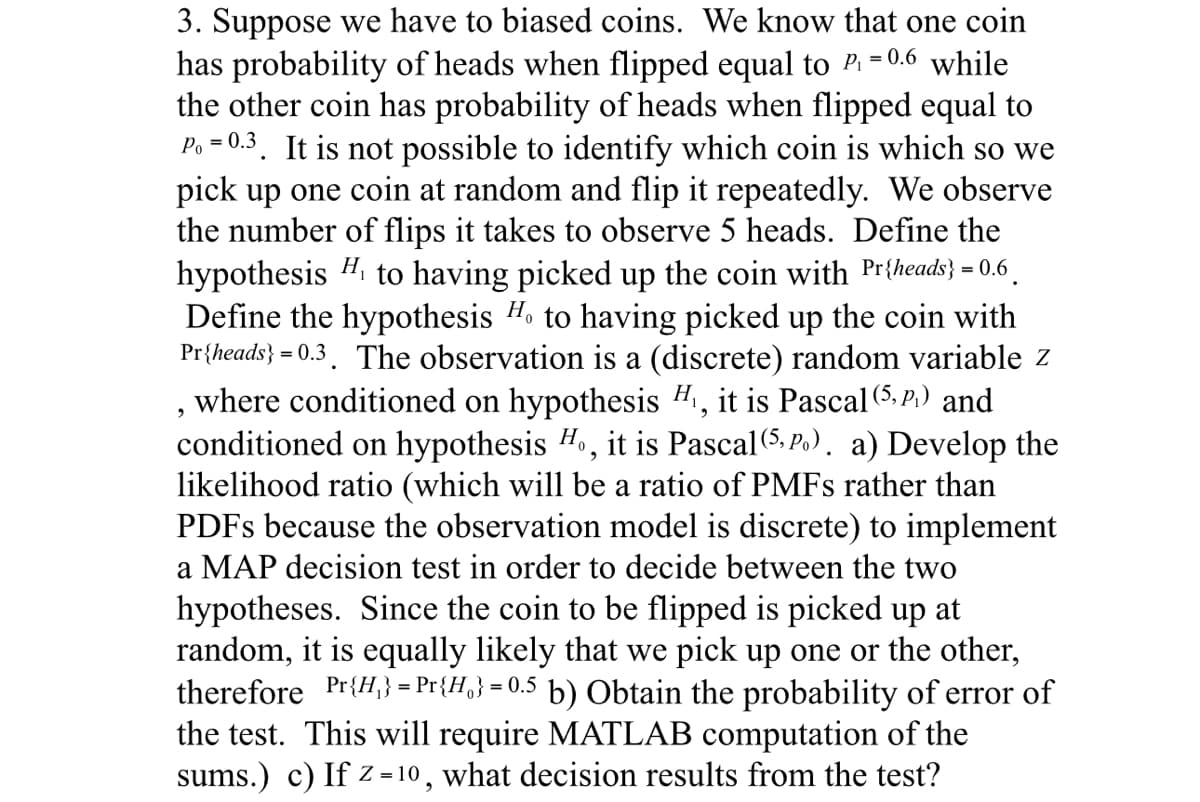3. Suppose we have to biased coins. We know that one coin has probability of heads when flipped equal to P₁ = 0.6 while the other coin has probability of heads when flipped equal to Po=0.3. It is not possible to identify which coin is which so we pick up one coin at random and flip it repeatedly. We observe the number of flips it takes to observe 5 heads. Define the hypothesis to having picked up the coin with Pr{heads} = 0.6 Define the hypothesis H to having picked up the coin with Pr{heads}=0.3. The observation is a (discrete) random variable z , where conditioned on hypothesis H₁, it is Pascal (5, P) and conditioned on hypothesis Ho, it is Pascal (5, P.). a) Develop the likelihood ratio (which will be a ratio of PMFs rather than PDFs because the observation model is discrete) to implement a MAP decision test in order to decide between the two hypotheses. Since the coin to be flipped is picked up at random, it is equally likely that we pick up one or the other, therefore Pr{H} = Pr{H} = 0.5 b) Obtain the probability of error of the test. This will require MATLAB computation of the sums.) c) If z=10, what decision results from the test?
3. Suppose we have to biased coins. We know that one coin has probability of heads when flipped equal to P₁ = 0.6 while the other coin has probability of heads when flipped equal to Po=0.3. It is not possible to identify which coin is which so we pick up one coin at random and flip it repeatedly. We observe the number of flips it takes to observe 5 heads. Define the hypothesis to having picked up the coin with Pr{heads} = 0.6 Define the hypothesis H to having picked up the coin with Pr{heads}=0.3. The observation is a (discrete) random variable z , where conditioned on hypothesis H₁, it is Pascal (5, P) and conditioned on hypothesis Ho, it is Pascal (5, P.). a) Develop the likelihood ratio (which will be a ratio of PMFs rather than PDFs because the observation model is discrete) to implement a MAP decision test in order to decide between the two hypotheses. Since the coin to be flipped is picked up at random, it is equally likely that we pick up one or the other, therefore Pr{H} = Pr{H} = 0.5 b) Obtain the probability of error of the test. This will require MATLAB computation of the sums.) c) If z=10, what decision results from the test?
Algebra & Trigonometry with Analytic Geometry
13th Edition
ISBN:9781133382119
Author:Swokowski
Publisher:Swokowski
Chapter10: Sequences, Series, And Probability
Section10.8: Probability
Problem 32E
Related questions
Question
Do not require matlab

Transcribed Image Text:3. Suppose we have to biased coins. We know that one coin
has probability of heads when flipped equal to P₁ = 0.6 while
the other coin has probability of heads when flipped equal to
P₁ = 0.3. It is not possible to identify which coin is which so we
pick up one coin at random and flip it repeatedly. We observe
the number of flips it takes to observe 5 heads. Define the
hypothesis H₁ to having picked up the coin with Pr{heads} = 0.6
Define the hypothesis Ho to having picked up the coin with
Pr{heads}=0.3. The observation is a (discrete) random variable z
where conditioned on hypothesis H₁, it is Pascal (5, P.) and
conditioned on hypothesis Ho, it is Pascal (5, P.). a) Develop the
likelihood ratio (which will be a ratio of PMFs rather than
PDFs because the observation model is discrete) to implement
a MAP decision test in order to decide between the two
2
hypotheses. Since the coin to be flipped is picked up at
random, it is equally likely that we pick up one or the other,
therefore Pr{H₁} = Pr{H} = 0.5 b) Obtain the probability of error of
the test. This will require MATLAB computation of the
sums.) c) If z=10, what decision results from the test?
Expert Solution
This question has been solved!
Explore an expertly crafted, step-by-step solution for a thorough understanding of key concepts.
This is a popular solution!
Trending now
This is a popular solution!
Step by step
Solved in 5 steps with 8 images

Recommended textbooks for you

Algebra & Trigonometry with Analytic Geometry
Algebra
ISBN:
9781133382119
Author:
Swokowski
Publisher:
Cengage

Algebra & Trigonometry with Analytic Geometry
Algebra
ISBN:
9781133382119
Author:
Swokowski
Publisher:
Cengage